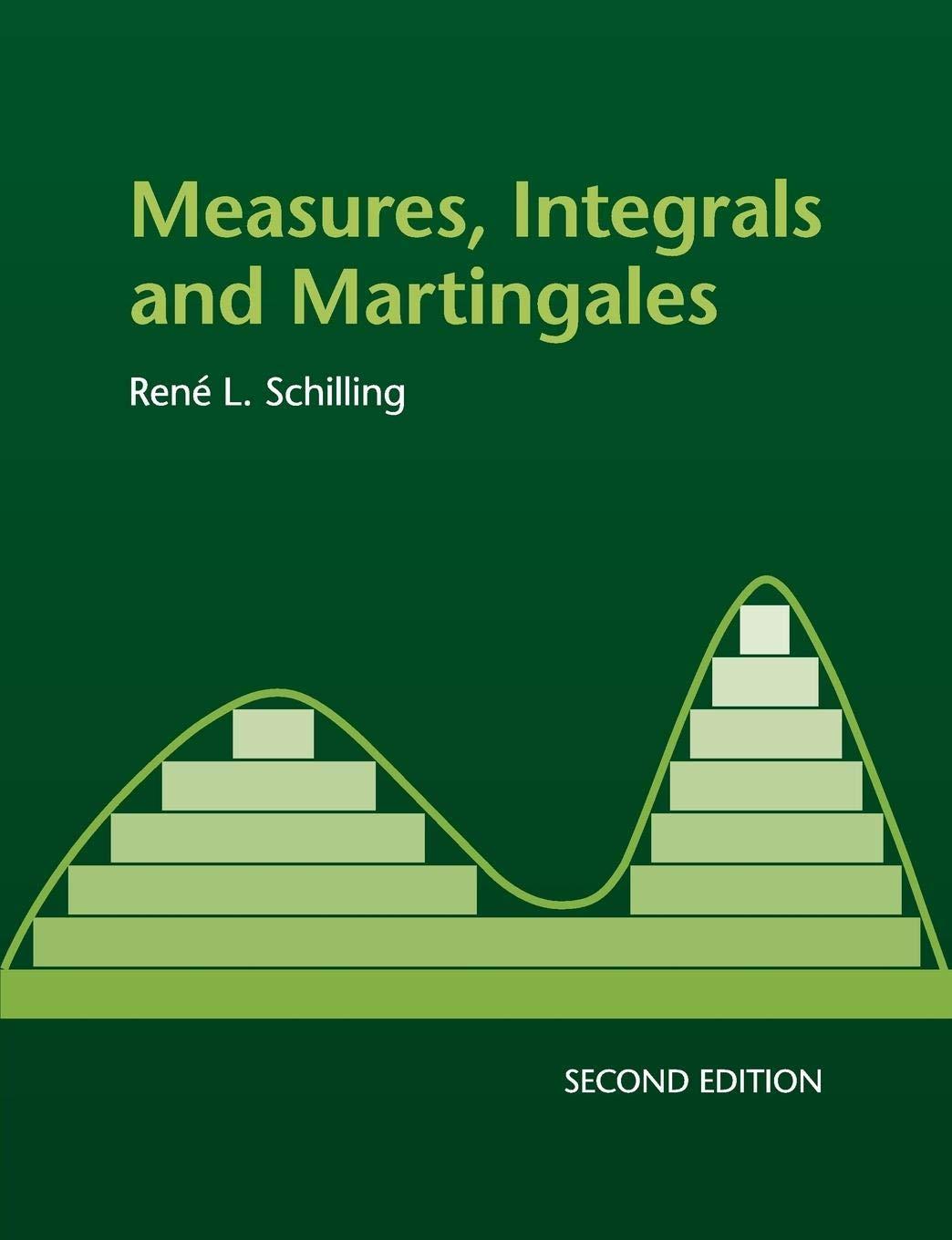Lvy's continuity theorem. The steps below sketch a proof of the following theorem. Theorem (P. Lvy; continuity
Question:
Lévy's continuity theorem. The steps below sketch a proof of the following theorem.
Theorem (P. Lévy; continuity theorem). Let \(\left(\mu_{i}ight)_{i \in \mathbb{N}}\) be a sequence of finite measures on \(\left(\mathbb{R}^{n}, \mathscr{B}\left(\mathbb{R}^{n}ight)ight)\). If the sequence of Fourier transforms \(\left(\widehat{\mu}_{n}ight)_{n \in \mathbb{N}}\) converges pointwise to a function \(\phi\) which is continuous at \(\xi=0\), then there is a finite measure \(\mu\) such that \(\mu_{i} ightarrow \mu\) weakly. In particular, \(\widehat{\mu}=\phi\) and the convergence of the functions \(\widehat{\mu}_{i}\) is locally uniform.
(i) If \(\lim _{i ightarrow \infty} \widehat{\mu}_{i}(\xi)=\phi(\xi)\) for every \(\xi \in \mathbb{R}^{n}\), then \(\phi(\xi)\) is a positive semidefinite function (see Problem 19.7 or 21.4 ). In particular, \(|\phi(\xi)| \leqslant \phi(0)\).
[ use that \((\phi(0))\) and
\[
\left(\begin{array}{cc}
\phi(0) & \phi(-\xi) \\
\phi(\xi) & \phi(0)
\end{array}ight)
\]
are positive semidefinite matrices.]
(ii) Show that \(u \mapsto \Lambda u:=\lim _{i} \int u d \mu_{i}, u \in C_{c}^{\infty}\left(\mathbb{R}^{n}ight)\), is a positive linear functional. [ use Theorem 19.2 .]
(iii) Show that \(\Lambda\) from (ii) satisfies \(|\Lambda u| \leqslant(2 \pi)^{n} \phi(0)\|u\|_{\infty}\) and extend \(\Lambda\) to a positive linear functional on \(C_{c}\left(\mathbb{R}^{n}ight)\). This allows you to identify \(\Lambda\) with a measure \(\mu\). [use Problem 15.13 .]
(iv) If \(\lim _{i ightarrow \infty} \widehat{\mu}_{n}(\xi)=\phi(\xi)\) for every \(\xi \in \mathbb{R}^{n}\), and if \(\phi\) is continuous at \(\xi=0\), then the sequence \(\left(\mu_{i}ight)_{i \in \mathbb{N}}\) is tight, i.e.
\[\forall \epsilon>0 \quad \exists R=R_{\epsilon}>0: \sup _{i} \mu_{i}\left(\mathbb{R}^{n} \backslash[-R, R]^{n}ight) \leqslant \epsilon\]
[use Problem 19.6 .]
(v) Show that \(\mu\) is a finite measure and \(\mu_{i} ightarrow \mu\) weakly.
(vi) Assume that \(\left(\mu_{i}ight)_{i \in \mathbb{N}}\) is a weakly convergent sequence of finite measures. Show that the sequence \(\left(\widehat{\mu}_{i}ight)_{i \in \mathbb{N}}\) is equicontinuous.
(vii) Conclude with (vi) and tightness that the sequence \(\left(\mu_{i}ight)_{i \in \mathbb{N}}\) converges to a finite measure \(\mu\), and that \(\widehat{\mu}_{i}(\xi) ightarrow \widehat{\mu}(\xi)\) uniformly on compact sets.
(ii) Show that \(u \mapsto \Lambda u:=\lim _{i} \int u d \mu_{i}, u \in C_{c}^{\infty}\left(\mathbb{R}^{n}ight)\), is a positive linear functional. [ use Theorem 19.2 .]
(iii) Show that \(\Lambda\) from (ii) satisfies \(|\Lambda u| \leqslant(2 \pi)^{n} \phi(0)\|u\|_{\infty}\) and extend \(\Lambda\) to a positive linear functional on \(C_{c}\left(\mathbb{R}^{n}ight)\). This allows you to identify \(\Lambda\) with a measure \(\mu\). [ use Problem 15.13 .]
(iv) If \(\lim _{i ightarrow \infty} \widehat{\mu}_{n}(\xi)=\phi(\xi)\) for every \(\xi \in \mathbb{R}^{n}\), and if \(\phi\) is continuous at \(\xi=0\), then the sequence \(\left(\mu_{i}ight)_{i \in \mathbb{N}}\) is tight, i.e.
\[\forall \epsilon>0 \quad \exists R=R_{\epsilon}>0: \sup _{i} \mu_{i}\left(\mathbb{R}^{n} \backslash[-R, R]^{n}ight) \leqslant \epsilon\]
[use Problem 19.6 .]
(v) Show that \(\mu\) is a finite measure and \(\mu_{i} ightarrow \mu\) weakly.
(vi) Assume that \(\left(\mu_{i}ight)_{i \in \mathbb{N}}\) is a weakly convergent sequence of finite measures. Show that the sequence \(\left(\widehat{\mu}_{i}ight)_{i \in \mathbb{N}}\) is equicontinuous.
(vii) Conclude with (vi) and tightness that the sequence \(\left(\mu_{i}ight)_{i \in \mathbb{N}}\) converges to a finite measure \(\mu\), and that \(\widehat{\mu}_{i}(\xi) ightarrow \widehat{\mu}(\xi)\) uniformly on compact sets.
Data from problem 19.7
Let \(\mu\) be a finite measure on \(\left(\mathbb{R}^{n}, \mathscr{B}\left(\mathbb{R}^{n}ight)ight)\) and denote by \(\phi(\xi):=\widehat{\mu}(\xi)\) the Fourier transform
Data from problem 21.4
Bochner's theorem. A function \(\phi: \mathbb{R}^{n} ightarrow \mathbb{C}\) is positive semidefinite, if the matrices \(\left(\phi\left(\xi_{i}-\xi_{k}ight)ight)_{i, k=1}^{m}\) are positive hermitian for all \(m \geqslant 1\) and \(\xi_{1}, \ldots, \xi_{m} \in \mathbb{R}^{n}\), i.e. \(\sum_{i, k=1}^{m} \phi\left(\xi_{i}-ight.\) \(\left.\xi_{k}ight) \lambda_{i} \bar{\lambda}_{k} \geqslant 0\) for all \(\lambda_{1}, \ldots, \lambda_{m} \in \mathbb{C}\). The steps below sketch the proof of the theorem.
Theorem (Bochner). A continuous function \(\phi: \mathbb{R}^{n} ightarrow \mathbb{C}\) is the Fourier transform of a finite measure \(\mu\) on \(\left(\mathbb{R}^{n}, \mathscr{B}\left(\mathbb{R}^{n}ight)ight)\) if, and only if, \(\phi\) is positive semidefinite.
Data from problem 15.13
Modify the proof of Theorem 15.11 and show that \(C_{c}^{\infty}\left(\mathbb{R}^{n}ight)\) is uniformly dense in \(C_{c}\left(\mathbb{R}^{n}ight)\).
Data from problem 19.6
Let \(\mu\) be a finite measure on \(\left(\mathbb{R}^{n}, \mathscr{B}\left(\mathbb{R}^{n}ight)ight)\). Prove P. Lévy's truncation inequality:
\[
\mu\left(\mathbb{R}^{n} \backslash[-2 R, 2 R]^{n}ight) \leqslant 2\left(\frac{R}{2}ight)^{n} \int_{[-1 / R, 1 / R]^{n}}\left(\mu\left(\mathbb{R}^{n}ight)-\operatorname{Re} \breve{\mu}(\xi)ight) d \xi
\]
[ show that the right-hand side equals
\[
2 \int\left(1-\prod_{1}^{n} \frac{\sin \left(x_{n} / Right)}{x_{n} / R}ight) \mu(d x)
\]
shrink the integration domain to \(\mathbb{R}^{n} \backslash[-2 R, 2 R]^{n}\) and observe that \(0 \leqslant \frac{1}{2} \sin 2 \leqslant \frac{1}{2}\) and \(x^{-1} \sin x<1, x eq 0\).]
Step by Step Answer:






